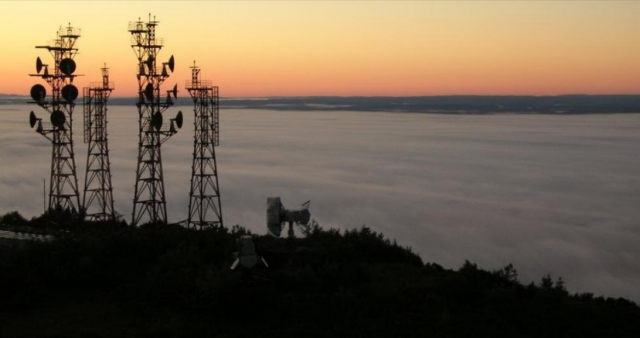Today marks 38 years since the first flight test of the last Soviet space giant, the superheavy launch vehicle Energia. It was launched on May 15, 1987. The technically successful project has reached a fully operational product that has flawlessly completed two test flights. But he never reached flight operation for reasons beyond his control. And the rocket launch went flawlessly then, although not without its peculiarities — and one of the participants in these tests was the author of Naked Science. But first things first.
Superheavy system concept
In the 1980s, the development of space technology continued the race of two space powers, the USSR and the USA. By that time, the Soviet Union was the first to send a human into space and had achieved impressive success in space stations and long-term crew stay in space. The United States landed people on the moon and began sending crews of six to eight people into low-Earth orbit. In both cases, this was done by superheavy (Saturn-5) and heavy (Shuttle) launch systems similar in launch mass and thrust, of which the Space Shuttle was largely reusable, losing only an external fuel tank during launch.
The USSR lost the moon race by not completing its first superheavy rocket, the N-1 (which launched the defining 100 tons into orbit in an accelerated version). By the 1980s, no one was interested in the Moon as a target, but expanding access to near-Earth orbits was relevant. Especially considering the projects of manned combat orbital stations, large and heavy. They required radically exceeding the mass and overall limits of the 20-ton blocks available for launching the heavy Proton, from which all Soviet orbital stations were built.
The concept of a reusable space plane was also very attractive. The cost of operating such systems took second place compared to their extensive capabilities, including military use. Reusable, numerous crews, the ability to deliver dozens of tons into space at once and take entire satellites from orbit with their return to Earth were weighty arguments in favor of the development of cruise space systems.
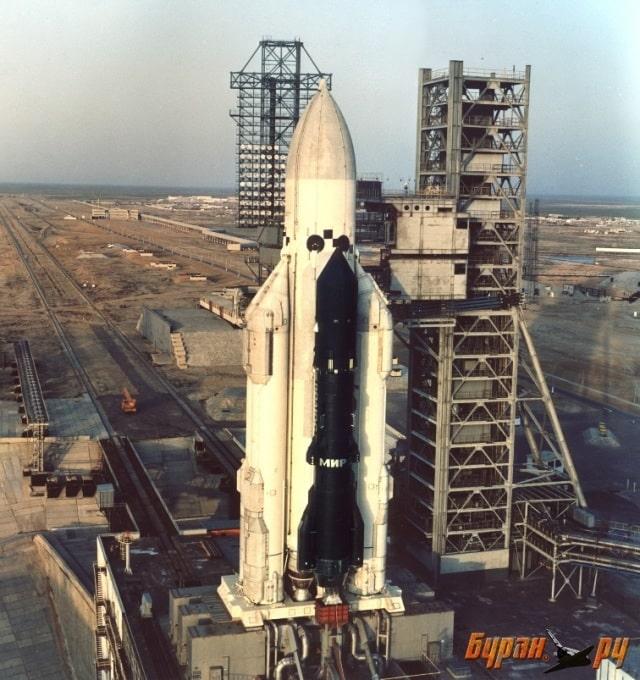
Superheavy launch vehicle "Energia" before the first launch
Image source: <url>, Vadim Lukashevich
It was reasonable and far-sighted to combine both directions of development in one super-heavy transport system. The same rocket could launch 100-ton stations and a reusable manned shuttle of the same mass into space. At the same time, a significant part of the design in the form of four first-stage boosters could be used repeatedly, up to 10 flights. They provided parachutes, soft landing engines and shock struts for landing.
This is how the superheavy space transport system Energia appeared in the USSR, which was in many ways similar to the American Space Shuttle system and differed in many ways from it. Like the American shuttle, it could launch a very similar space cruise ship Buran into orbit and store accelerators on parachutes. But the Space Shuttle could not do anything even close to the Energia payload, which could deliver a 100-ton module of any purpose into orbit and leave it there as a payload, more than three times exceeding the maximum 30 tons of the Shuttle payload. And at the same time, like him, she could launch the cruise space "Buran" into orbit.
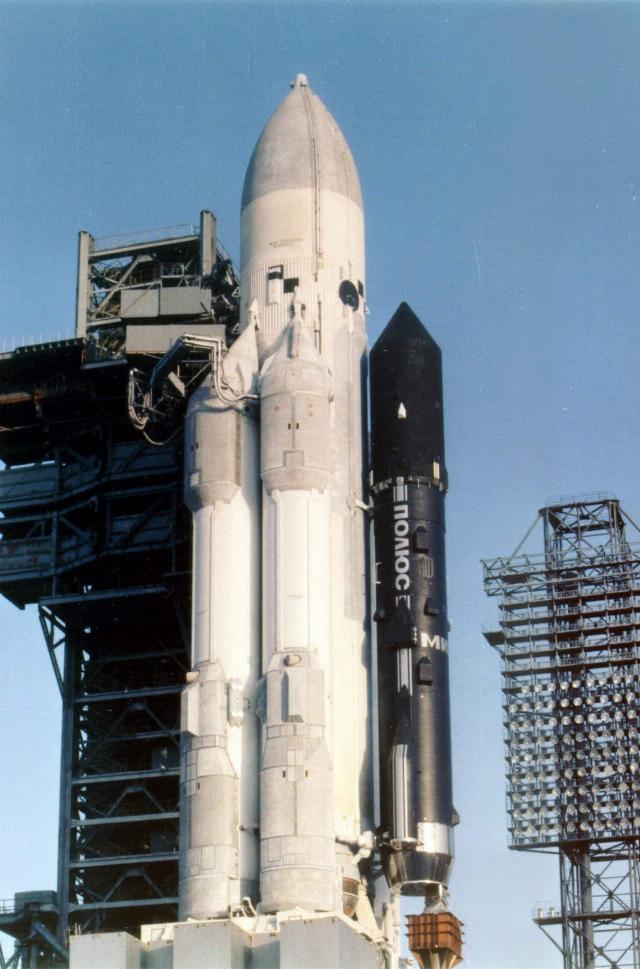
Energia with the Skif-DM payload at the launch facility
Image Source: Roscosmos, Ivan Petrov
A huge amount of materials has been written about the history of the development of Energia, and it is not our intention to retell them. It should be noted that the product development and its flight tests are different areas, although they are close. This is clearly seen, for example, in aviation: test pilots do not design an airplane, even if they make their comments during and after the flights of the aircraft. Rocket technology testers are also not the main designers. They have their own special activities, organizational structures, technical equipment, and work algorithms.
The trials of heaven
The missile systems being created, which have reached the metal and have passed various bench tests, are entering the most important key stage — flight tests. This is a complex process of checking and debugging during the launches of all design solutions, and with an unknown result in advance. The example of the unsuccessful four test launches of the first Soviet superheavy N-1 is quite clear, the result was the cessation of development and the completion of the program. Of course, the second half of the 80s was already a different time, with a different level of technology, with massive computer calculations and increased development experience.
By 1987, everything was ready for the first test launch of the latest super-heavy launch vehicle, Energia. A new launch complex was built, tested and prepared for launch at Baikonur. Around it, for many kilometers, there was an extensive and numerous own measuring infrastructure of the cosmodrome, which worked to support the launches of all rocket systems (and not only for space purposes) flying from Baikonur.
Numerous measuring points of various "calibres" and equipment were also located along the route (ground projection of the trajectory) of the launch and flight in orbit. The work of the second stage of the carrier is already poorly visible from the cosmodrome, close to the horizon, or not visible. Especially the completion of its work, which sometimes takes place hundreds of kilometers from the start. And the rocket may have a third stage, the operation of which must be monitored completely, until the engine is finally turned off and the active launch site is completed.
The farthest ground-based measuring complexes from Baikonur are already in the Far Eastern region. What do they actually measure? It's not a secret.
Movement is the main outcome and measure of the launch vehicle's operation. Its entire task is to inform the payload of a given velocity vector, which is formed by the last stage of the rocket. This velocity must have a set value, be directed in space in a set way, and be anchored to a point with set geographical coordinates at a set altitude at a set point in time.
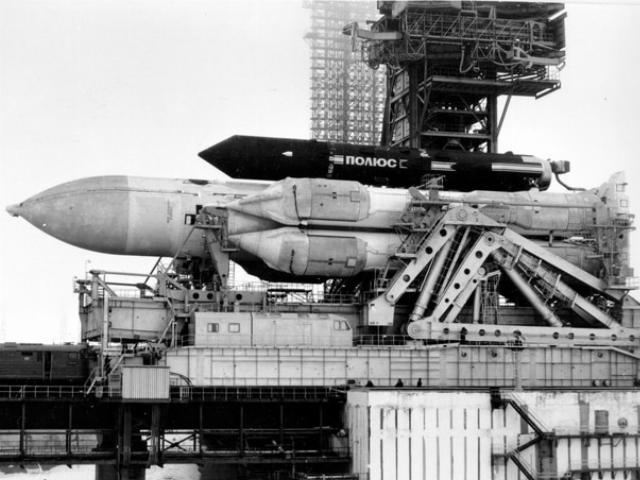
The Energia launch vehicle at the launch facility before being installed in an upright position
Image Source: Roscosmos, Ivan Petrov
As you can see, there are quite a lot of parameters for speed, and it is not so easy to achieve their exact combination. Moreover, this is actually impossible and almost never happens, except by accident. A paradox? No, this is a characteristic feature of real flight.
Any technical system works with an error, with an error in the execution of the task. Which itself is a complex of various errors: execution errors, method errors, on-board measurement errors, and many others. It is important that the accuracy of the launch vehicle remains within the specified limits. And the deduction error, which breaks down into errors in the magnitude of the velocity, its direction, coordinates, altitude and time, must remain within acceptable limits as part of the further flight task.
This is the actual movement of the rocket payload, which turned out in reality and absorbed all the errors and errors of the carrier, it is necessary to measure. This is called trajectory measurements. They are performed by various radar systems, as well as other systems, for example, radio engineering.
Another main task of the tests is telemetry. In it, all measurements are carried out on board the rocket and payload by sensors located in many necessary places and measuring various physical quantities. These are temperatures, pressures, voltages, currents, various accelerations, including alternating ones with high frequency — vibrations et cetera. Data from the sensors is transmitted by radio waves to the surrounding space and reaches ground-based receiving devices. And they are sent to the recording equipment complexes, where they are recorded for subsequent analysis. In general, all this is called a radio telemetry system of one type or another. We have described more details about the details and algorithm of radio telemetry in missile tests here .
Points on the territory
During Soviet times, only specialized floating marine measuring complexes were located beyond the coastline of the Far East. They occupied the right geographical point in the World's oceans and performed their part of the work there, similar to ground-based measuring points. Some could also perform a command function, sending commands aboard the satellite. Or even two-way radio communication with the crews in orbit.
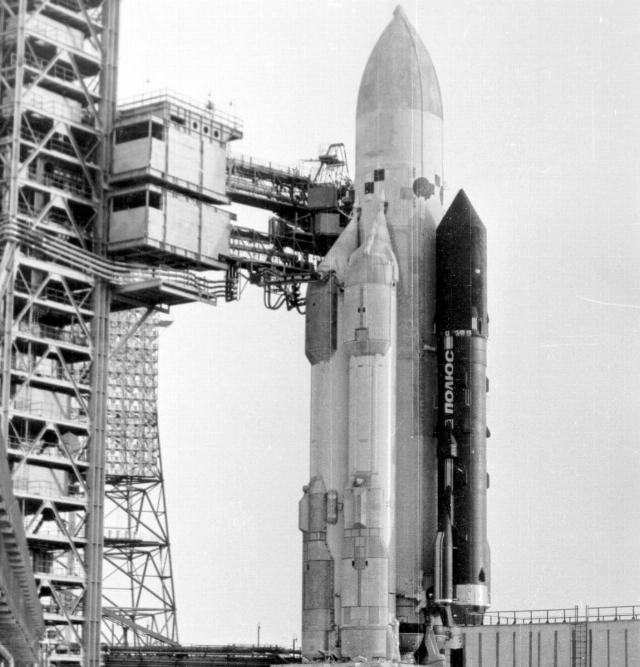
The Energia launch vehicle with a payload at the launch facility
Image Source: Roscosmos, Ivan Petrov
Among all the variety of testing structures, another, most specialized and unusual measuring complex was operating that day. It is located east of all other ground-based measuring points in Kamchatka. The territory of Eastern Chukotka is even further east, but also much further north; there are no launch trajectories and measurement work is not carried out.
This specific task lies at the deep intersection of ballistics, aerodynamics and other additional aspects, from seismic waves to the operation of the nuclear warhead stuffing. Spaceports and positional launch areas of combat intercontinental missiles do not have such features. This imposes unique features on the Kamchatka receiving range.
The uniqueness of the Kamchatka expanses
For example, trajectory measurements of the movement of a warhead in the atmosphere are measured not by radar, but by optical methods, using optical and infrared phototheodolites. Why not use radar, as they accompany a rocket taking off? Because a warhead travels through the atmosphere much faster than a rocket taking off. Wrapping it with air creates shock ionization (multiple in places), wrapping the product with plasma.
This plasma trail exists for a long time and stretches for kilometers in the sky. Sometimes at night, in clear weather, it is simply visible visually as a strip of greenish glow that fades for 20 seconds or longer. However, it is more often visible beyond the breeding stage entering the atmosphere, and the warhead is usually too dazzling, weakening the visual perception of its wake.
For radar, this ionization trace is visible as an object reflecting the radio signal. And it is by no means a point; it is much more difficult for a radar to determine the current coordinates of a point on it than the position of a rocket stage clearly limited in space.
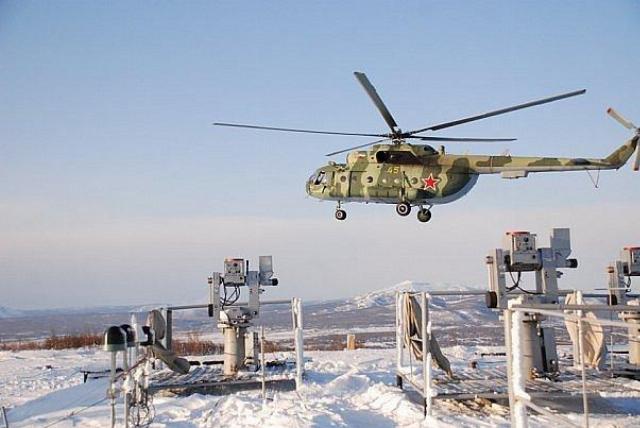
Uncovered and vertically upward phototheodolites of the FRS-2 "Woodpecker" photorecording station (right and left below the helicopter). Kura landfill, Kamchatka. Picture: N. Petrov. Source: VK
The phototheodolites, located at three measuring points tens of kilometers apart, will work out the task using the usual triangulation method. They will determine the angular position of the bright point of the warhead in the sky, and as a result, the position of the warhead in space (at a specific time) will be determined with an error of several meters at a distance of fifty kilometers. But optical devices have their own vulnerability — the weather. They won't see anything in the fog or behind the clouds.
Another system measures the trajectory in the last kilometers of flight and also not by radar — this is the radio engineering total-difference rangefinder system SRDS "Wave". The third system does not even measure the trajectory, but only one of its points — the end point, which is also the point of incidence. And it does this through three independent channels, including seismic and ballistic waves; this is a seismic-acoustic system for the operational determination of the coordinates of the points of impact of the Volcano SAS.
There are other unusual systems at the Kamchatka receiving range. For example, local telemetry includes an unusual special telemetry system. It is not measuring, but recording: it does not measure physical quantities, but registers events in the cocking system and the firing system of the thermonuclear warhead. We wrote more about the work of these purely combat systems and special telemetry here .
Technically, these are highly sensitive receiving antennas (antenna-feeder devices) of unusual "cosmic" shapes, sharply contrasting with the untouched natural landscapes of the area.
They are coupled with a high-speed BRS-4M radio telemetry station, the speed of which is needed, among other things, to measure the vibration profile on board the target. Vibrations can be kilohertz. How do I record them? Only by high-speed operation, which will fully describe the profile of fluctuations in time, otherwise the nature and details of the vibrations will not be understood. It is a universal, broad-based system for conducting and recording a wide variety of measurements.
Work on a flyby target
Here we note that these radio telemetry systems have a steady signal reception range of up to two thousand kilometers when the target is still far away in space. This situation is natural a few minutes before the warheads enter the atmosphere.
But there is also an infrequent situation when a long range of signal reception is also needed. Sometimes intercontinental ballistic missiles are launched at maximum range. It varies from type to type, and is usually 10-12 thousand kilometers long (along the shortest line on the Earth's surface between takeoff and fall). When launching at maximum range, the distances from Baikonur, Kapustin Yar or Plesetsk to Kamchatka are small, it is only about half the way.
When launched at maximum range, the warheads and the firing stage of the missile arrive in the Pacific Ocean, in an area about a thousand kilometers from Hawaii. They pass the Kamchatka test site in space, hundreds (sometimes more than a thousand) kilometers above our planet. Telemetry works quite steadily for these purposes, which are called flight targets in such a situation.
You can go into stories about these cases further, but theory is theory, and practice is practice. She usually makes her own adjustments to what is happening. Let's take a look at how the first launch of Energia took place from the perspective of the measuring point of the Kamchatka receiving range.
Combat work
The task of working on the flyby target was for the next combat operation at the IP-14 measuring station, scheduled for May 15, 1987. Optical measuring devices — two photorecording stations FRS-2 "Woodpecker" with two phototheodolites on each — were not used. They won't see the target in space anyway. And the telemetry stations were used in the usual way. But for an unusual purpose.
The beam of vision of the Zhemchug-M telemetry antennas is highly sensitive, but very narrow for the sake of receiving range. The target, usually a warhead with its launch number, emits its telemetry signal weakly because it is spherical, and its onboard transmitter is low in power. Where and how will the warhead pass through the sky in this launch — how would such a high-precision antenna know to aim at the target? The ballistic center is working for this purpose. According to the launch project, he calculates for all measuring points how the entire launch and fall process will take place relative to them. It gives each observer visibility of the target in his field of vision in relation to flight time.
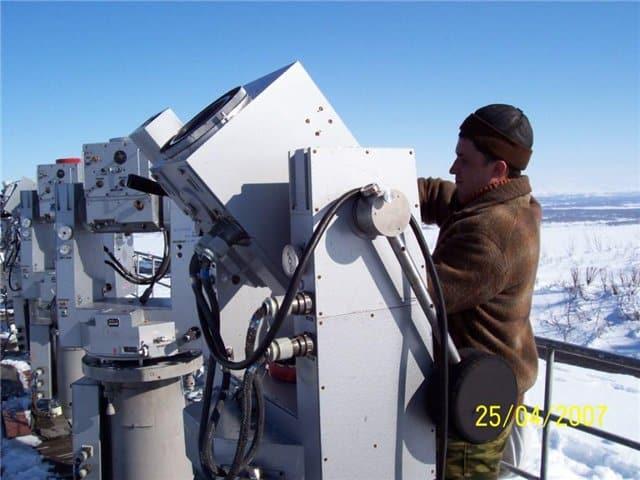
An operator near the phototheodolites of the FRS-2 Dyatel station on the roof of the technical building of the measuring station. Kura landfill, Kamchatka. Picture: A. Zhilenko. Source: VK
A target designation, or TSU, arrives at the measuring point a few days before launch. This is a top secret document that takes up many pages, in which the calculated ballistic position of all targets is described in detail (the 15A18M missile had up to 14 warheads in a combat warrant in the sky; in multiple rocket launches there are even more of them) above the local horizon at successive moments of flight time. The calculated azimuth, location angle, and distance are calculated every 10 seconds when the target is still far away and moving slowly in the sky. Later, every five seconds; and every second when the target flies close to the highest offset in the sky.
According to these target indications, the antennas rotate to the desired points in the sky for the designated target during a comprehensive training session a day or two before combat work. And later, combat work is carried out on them: at a given moment in time, the antennas are at set angles to the horizon (elevation) and north (azimuth), controlled by the station operators. Then they see the target in the center of their field of view (antenna pattern) and listen carefully to its signal from afar.
Tester Petrov, readiness and fuel assemblies
Petrov, according to his habit, looked at the numbers in the newly arrived data centers and saw an amazing thing there. The azimuths on the target, starting from the usual northwesterly direction of arrival of the warheads, turned further north to the usual directions at the drop points. But they did not stop there, but grew further, turning to the east, and even gradually moved away from it to the south.
For the first time, Petrov saw azimuths with values of 90 degrees or more in target indications. This means that the target came to the training ground as usual, and then for some reason flew further into the ocean, to the east and later to the south. This meant one thing: there was work to be done on the flight path.
Zhemchug-M antenna-feeder device for receiving a telemetry signal. The working part of the antenna is on the right, pointing towards the horizon. On the left, the surfaces of the wind compensators are visible spaced on the brackets. Picture: V. Sergeev. Source: VK
Something was flying from Baikonur. The type of rocket, the usual alphanumeric index, was not specified for this work, only the word "product". Preparations began in the usual manner, in the evening. It's probably worth telling you what readiness is.
Readiness is the discrete time remaining until launch. It is expressed in segments of different lengths. Readiness has its own clear sequence and during combat work is brought to the point by a top-secret document on special communications. They start with a four-hour readiness. Every readiness is immediately communicated to all the facilities involved in the work.
The stations must then confirm their readiness for operation. The general report on the readiness of the point goes further to the center. It contains not only measuring instruments, but also the station of the PP SEV (the receiving point of the unified time system) and the DES, a diesel power plant that provides a large flow of energy to the meters, and a communications center, and other structures that supply them with accurate millisecond time. Three hours of readiness is replaced by two-hour and one-hour; in general, this is still a comfortable time for station operators.
With one hour of readiness, the main phase of what is happening begins. Readiness increases, and a half-hour readiness is announced next. Through the slightly open windows of the control rooms, where the measuring stations are located, the fading hum of turboprop engines can be heard. These are planes with special monitoring equipment (alas, it's a tautology, but you can't get the words out of the song, that's what it's called) sailed in the direction of their work area in the sky. The next half-hour is 15 minutes of readiness. Everyone is in their places, you can no longer leave. A 10-minute readiness is received and brought to the central post. After five minutes, the last, five-minute readiness is announced.
After five minutes of readiness, everyone is waiting. The central post, the Fed operators, the telemetrists. Time is passing. Minute. Another. Third. Now we need a signal that everything has begun. The main signal. There is no biting of lips, no finger tapping, and no other meaningless gestures and movements. Everyone is ready and waiting for the signal, and then how the fate will fall, more precisely, how the warhead drop points will fall. Maybe nothing will arrive at all, as it has already happened.
It arrives at the destination in the form of a millisecond fuel assembly, the exact start time, linked to Moscow time. This is the measured response time of the lifting contact of the product from the starter device. It arrives within half a minute from the calculated zero, if all is well. Its numbers mean that the rocket went into the sky from the launch site, whatever that position may be: the launch pad of the cosmodrome, the mine of the positioning area, the wheeled vehicle, the submarine — the lifting contact opened, and the rocket began its flight. Why and who needs these seconds and milliseconds?
The fuel assembly is set to program the position of the antennas in the sky. They are now aimed at the horizon, at the point of the future radio approach of the target; but the countdown is already based on the actual flight time, not the estimated one. Sometimes the antennas are pre-directed just above the horizon, by a degree, because at the moment of the ballistic sunrise of the target (crossing the horizon) it is still completely inaudible. Rising above the horizon means that the target is approaching and its signal is being received steadily. We will omit numerous other details as separate test conversations. The first person to receive the fuel assemblies was Petrov. But why did we focus so much on this fuel assembly? Because it didn't come and didn't come.
Start with transfers
After being ready for one hour, instead of the next half-hour, work was postponed for an hour. Postponements are common; stand-off (termination) of combat work is less frequent, postponement is more frequent. Postponements are made for any reason that prevents an effective launch. And this result must be measured; and if it is not measured, there is no evaluation of the launch, and it has become in vain. They are postponed both for launch reasons and for the receiving range. There may be bad weather on it, and its optical means will not work. Sometimes it's important, sometimes it's not, if they're not involved, like in this job. The postponement of the launch was now from the launch at Baikonur.
It usually took an hour of postponement, and the problem was resolved. If not, the next postponement is for another hour, and a new hourly readiness. The waiting time and combat work at the points with such transfers takes up to one or two in the morning. It doesn't happen often, but it does happen. So it was on this May evening. The first postponement was followed by the second, by an hour. There's a third one after him. The evening turned smoothly into the night of the following day, on May 16. By four o'clock in the morning, both the station calculations and the shift shift at the technical building had become numb. And the postponements continued, and each time for an hour.
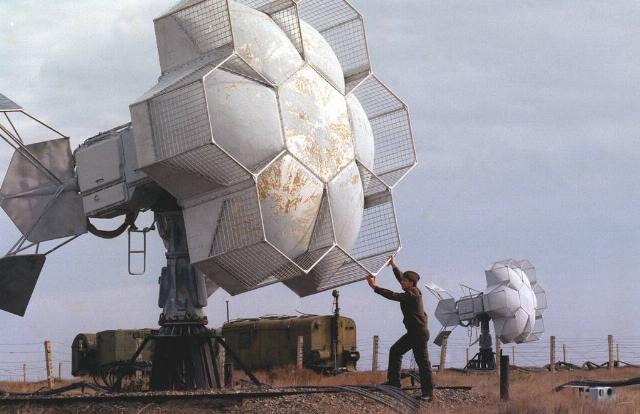
The Pearl-2 telemetry antenna (antenna-feeder device) for receiving a telemetry signal from a target. The working part of the antenna is located several degrees above the horizon. Picture: S. Vasiliev. Source: VK
It's dawn. Morning came. The May snows were illuminated by the sun peeking out from under the horizon. It was a good thing that the optical means did not work — they would have to change the night filters to more powerful daytime filters due to the changed lighting mode. At six in the morning, a half-hour readiness was completed, followed by all short ones, including a five-minute one.
After half past six in the morning, after a long night of waiting in readiness, the special communications telegraph began tapping: "SUN. SUN. SUN. ("Attention, Signal!" — approx. the author) The launch has been completed. TVS 21 hours 30 minutes ... seconds ... milliseconds.". Combat work has entered the main phase of the actual task.
The remaining suborbital target
At that time, the "Energy" was rapidly accelerating in the darkened sky over the Kazakh semi-desert, throwing off a huge jet of mixed oxygen-kerosene flame and red-hot water vapor. The launch thrust of the simultaneously operating side boosters and second-stage engines reached 3,425 tons, roughly corresponding to the 3,500 tons of launch thrust of the Saturn-5 rocket. After 2.5 minutes, the kerosene flame of the side boosters went out, and they moved away from the second stage, which was still operating. Then the rocket went on purely steam propulsion. Eight minutes after liftoff, the stage turned off the engines.
The Buran, which was supposed to be launched into low orbit by Energia, not only resembled the American Space Shuttle in appearance, but also repeated its flight-proven launch ballistics. The main engines of the Shuttle turned off a little earlier than the orbit, when it just barely reached the orbital speed. The Shuttle made the remaining small increase in speed with its orbital maneuvering engines. This made it possible to dump a large external fuel tank on a suborbital trajectory, which ensured a rapid and inevitable entry of the tank into the atmosphere in the design zone.
If it had entered orbit, it would have required a separate operation to bring it down from there, with the braking pulse of the engines, with the risk of failure of this braking and the uncontrolled fall of a large structure with an incalculable spread of time and place. And on a suborbital trajectory, nothing needs to be done with the tank anymore — two reliable and inescapable forces will naturally do everything themselves: gravity and air resistance.
The Energia—Buran bundle operated similarly, preventing the second stage from entering orbit, with the Buran being propelled into orbit by its orbital maneuvering engines. The same ballistics worked when launching another payload, which was supposed to reach orbit with its own engines. And the first launch happened exactly like that.
"Energia" performed the launch perfectly. She launched a massive dynamic mock-up of the Skif-DM (with inscriptions on board the Polyus and Mir-2) combat laser orbital station, 37 meters long and weighing almost 80 tons. This payload was also new, it was tested for the first time, and it failed to fulfill the launch task. Due to failures in the Skif-DM orientation system, it was unable to increase its speed to the orbital one and remained on a suborbital trajectory leading to the atmosphere.
By seven o'clock, this tiresome contraption had passed close to the test site up there, on its way into space. The measuring station, created and designed to work with suborbital targets, has worked on the target, which should become an orbital one. But the target seemed to obey the nature of the polygon and, contrary to its purpose, also became suborbital. The payload gradually sank into the Pacific Ocean, ending the launch.
Tired and exhausted, the telemetrists trudged to the unit. No less exhausted, Petrov, without even asking how it turned out to receive the signal, continued to work in the technical building, waiting for the morning shift.
After changing and arriving at the location of the unit, the night shift did not even go to breakfast, immediately climbed into bed and fell into a deep sleep. It was only after sleeping off the night's combat that everyone learned from television reports that a new Energia launch vehicle had been successfully launched in the Soviet Union.
In the cohort of superheavy rocket testers
All the specialists who worked on this launch as part of the launch and other cosmodrome teams, duty shifts and calculations of measuring stations entered a rare category of participants in flight tests of superheavy rockets. There were only 16 such tests in the history of cosmonautics, all of them took place in two countries: the USSR and the USA.
The Soviet Union conducted six flight tests of superheavy systems: four H-1 launches, all emergency, and two successful Energia test launches. In the United States, flight tests of superheavy rockets include the first two launches of the Saturn-5 rocket (in 1967 and 1968) and eight launches of the Starship system over the past two years (April 2023 - March 2025).
Of all the superheavy systems, Energia turned out to have the most illogical fate. The Soviet "N-1" did not go into operation, in a series of emergency launches without achieving successful results. The American Saturn-5 has successfully passed the tests and has switched to flight operation. Elon Musk's Starship is just being tested and has not yet achieved fully successful results, paving the way for regular flights. And only Energia, after two completely successful test launches, did not go into flight operation — this was no longer related to the rocket and its flight tests.
Everyone sees and remembers events from their own perspective. Petrov remembered this day and this launch, one of the many launches in which he had worked. He stood out for his peculiar character and unsurpassed duration of combat work. And a rare category of superheavy rocket flight tests, which remain a participant for life.
Nikolai Tsygikalo
